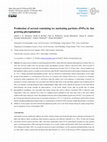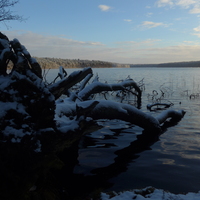Papers by Gerardo Gold-bouchot
AGU Fall Meeting Abstracts, Dec 1, 2018

The histological changes in the liver, kidney, spleen, and gills of S. papillosum from the contin... more The histological changes in the liver, kidney, spleen, and gills of S. papillosum from the continental shelf of the Yucatan Peninsula, Gulf of Mexico, and their statistical associations with environmental conditions and pollutants were assessed in 2010, 2011, and 2012. We evaluated the extension and severity of the lesions through a degree of tissue change (DTC) and, with the sum of the number of lesion types within each of their DTC stages, we determined the histological alteration index (HAI). The liver and kidney were the most affected organs, with HAI values > 100. Fish with the most severe damage were observed on the Campeche Bank and the Caribbean Sea, in contrast with those collected from the northern Yucatan continental shelf. The presence of foci cellular alteration and abundant melanomacrophage centers indicated that these flatfishes were chronically exposed to environmental stress factors. Redundancy analyses showed strong associations between HAI values and hydrocarbo...
Heliyon, 2019
Chemical characterization of the presence of oil in environmental samples are performed using met... more Chemical characterization of the presence of oil in environmental samples are performed using methods of varying complexity. Extraction of samples with an organic solvent and analysis by fluorescence spectrometry has been shown to be a rapid and effective screening technique for petroleum in the environment. During experiments, rapid analysis of oil by fluorescence provides the opportunity for researchers to modify the experimental conditions in real time. Estimated Oil Equivalents (EOE) relies on the fluorescence measurement of the aromatic compounds to estimate the oil concentration. The present intercalibration study was designed to investigate whether different fluorometer instruments can reliably measure EOE and whether the results are intercomparable. Additionally, the need for extraction of oil compounds into an

Environmental Science and Pollution Research, May 22, 2021
Extensive data exist on the optical properties of CDOM from terrestrial and coastal environments,... more Extensive data exist on the optical properties of CDOM from terrestrial and coastal environments, yet the open oceans have been historically under-sampled. Consequently, the source and structural basis of marine CDOM optical properties are still debated. To address this issue, detailed optical measurements were acquired for both untreated and sodium borohydride (NaBH 4) reduced natural waters and C18 extracts (C18-OM) across the Equatorial Atlantic Ocean. Except in regions of upwelling or in the vicinity of the Congo River outflow, CDOM absorption coefficients and visible emission intensity were far smaller for surface waters (a CDOM (355): 0.057-0.162 m −1 ; λ ex /λ em =350/450 nm: 0.396-1.431 qse) than for waters below the mixed layer (a CDOM (355) 0.084-0.344 m −1 ; λ ex /λ em =350/450 nm: 0.903-3.226 qse), while spectral slopes were higher (surface: 0.019 to 0.025 nm −1 ; deep: 0.013 to 0.019 nm −1), consistent with photobleaching of CDOM in surface waters. Distinct emission bands were observed in the ultraviolet, primarily at excitation/emission wavelengths (λ ex /λ em)=280/ 320 nm, but also at λ ex /λ em =300/340, 300/405 and 320/380 nm for some stations and depths. In contrast, visible emission exhibited maxima that continuously redshifted with increasing λ ex (>330 nm), a property characteristic of CDOM from estuarine and coastal environments. Further evidence that CDOM in the offshore waters of this region is composed of a major terrestrial component includes: 1) similar spectral dependencies of the emission maxima and fluorescence quantum yields; 2) a large Stokes shift in the emission maxima with short-wavelength excitation (λ ex =280 nm); 3) correlation of visible emission intensities with absorption at λ ex =280, 320 and 450 nm, with absorption to fluorescence ratios comparable to those found in estuarine and coastal environments; 4) affinity of C18 cartridges for the long wavelength (visible) absorbing and emitting material, but not the UV emitting material; 5) preferential loss of visible absorption and substantially enhanced blue-shifted emission in the visible following borohydride reduction of both the Equatorial Atlantic waters and the C18-OM of these waters. These results support the occurrence in offshore waters of a major terrestrial CDOM component that absorbs in the UV and visible and emits in the visible, as well as marine CDOM components that absorb and emit in the UV. The results further demonstrate that the simultaneous acquisition of complete spectral absorption and emission properties, combined with chemical tests (C-18 extractions, borohydride reduction) can provide a far clearer picture of the sources and cycling of CDOM within the oceans.

Sea spray aerosol contains ice nucleating particles (INPs), which affect the formation and proper... more Sea spray aerosol contains ice nucleating particles (INPs), which affect the formation and properties of clouds. Here, we 15 show that aerosols emitted from fast growing marine phytoplankton produce effective immersion INPs, which nucleate at temperatures significantly warmer than the atmospheric homogeneous freezing (-38.0 ∘ C) of pure water. Aerosol sampled over phytoplankton cultures grown in a marine aerosol reference tank (MART) induced nucleation and freezing at temperatures as high as-15.0 ∘ C during exponential phytoplankton growth. This was observed in monospecific cultures representative of two major groups of phytoplankton: a cyanobacterium (Synechococcus elongatus) and a diatom (Thalassiosira weissflogii). Ice nucleation 20 occurred at colder temperatures (-28.5 ∘ C and below) when the cultures were in the stationary or death phases of growth. Ice nucleation at warmer temperatures was associated with relatively high values of the maximum quantum yield of photosystem II (FPSII), an indicator of the physiological status of phytoplankton. High values of FPSII indicate the presence of cells with efficient photochemistry and greater potential for photosynthesis. In the North Atlantic Ocean, high net growth rates of natural phytoplankton assemblages were associated with marine aerosol that acted as effective immersion INPs at relatively warm 25 temperatures. Data were collected over 4 days at a sampling station maintained in the same water mass as the water column stabilized after deep mixing by a storm. Phytoplankton biomass and net phytoplankton growth rate (0.56 day-1) were greatest over the 24 hours preceding the warmest mean ice nucleation temperature (-25.5 ∘ C). Collectively, our laboratory and field observations indicate that phytoplankton physiological status is a useful predictor of effective INPs, and more reliable than biomass or taxonomic affiliation. Ocean regions associated with fast phytoplankton growth, such as the North Atlantic during the annual spring bloom, 30 may be significant sources of atmospheric INPs. 1 Introduction Atmospheric aerosols significantly influence the Earth's radiative budget and climate through direct (scattering and absorption of light) and indirect effects (modifying cloud formation, properties and lifetimes) (Seinfeld et al., 2016). Clouds form through interactions between aerosol and water vapor, with cloud condensation nuclei (CCN) catalysing the formation of water droplets 35 and ice nucleating particles (INP) catalysing the formation of ice crystals (

Comparative Biochemistry and Physiology C-toxicology & Pharmacology, Aug 1, 2009
Glutathione s-transferases (GST) play a critical role in the detoxification of exogenous and endo... more Glutathione s-transferases (GST) play a critical role in the detoxification of exogenous and endogenous electrophiles, as well as the products of oxidative stress. As compared to mammals, GST activity has not been extensively characterized in reptiles. Throughout the globe, most sea turtle populations face the risk of extinction. Of the natural and anthropogenic threats to sea turtles, the effects of environmental chemicals and related biochemical mechanisms, such as GST catalyzed detoxification, are probably the least understood. In the present study, GST activity was characterized in four species of sea turtles with varied life histories and feeding strategies: loggerhead (Caretta caretta), green (Chelonia mydas), olive ridley (Lepidochelys olivacea), and hawksbill (Eretmochelys imbricata). Although similar GST kinetics was observed between species, rates of catalytic activities using class-specific substrates show inter- and intra-species variation. GST from the spongivorous hawksbill sea turtle shows 3-4.5 fold higher activity with the substrate 4-nitrobenzylchloride than the other 3 species. GST from the herbivorous green sea turtle shows 3 fold higher activity with the substrate ethacrynic acid than the carnivorous olive ridley sea turtle. The results of this study may provide insight into differences in biotransformation potential in the four species of sea turtles and the possible health impacts of contaminant biotransformation by sea turtles.

Bulletin of Environmental Contamination and Toxicology, Dec 22, 2021
There is relatively little information on pollution problems in the Southern Gulf of Mexico as co... more There is relatively little information on pollution problems in the Southern Gulf of Mexico as compared to other regions of the world. After the Macondo well Deep-Water Horizon Blowout many studies were funded by the Gulf of Mexico Research Initiative (GOMRI) and other funding sources on concentrations, fate, and effects of hydrocarbons in the northern Gulf of Mexico (GoM). Similar efforts by Mexico were funded, first through a series of three cruises per year for three years, and smaller projects studying coastal lagoons, sea grass beds, pollutants in sea turtle hatchlings, amongst others, and later through a major funding effort by the joint Department of Energy-CONACyT Energy Research Fund. These two programs greatly improved what we know of the Southern GoM, and particularly about the deeper parts, and the northern portion of the Mexican GoM. This special issue of BECT includes 16 papers, 15 from the two funding programs mentioned above, which give a broad perspective of pollution research in this area. Some papers discuss environmental distributions of metals, other papers discuss possible effects in the field, and some papers discuss laboratory experiments. Cruz-Santiago et al. report genotoxicity in Giant Tadpoles (Rhinella marina) collected in industrial areas from the Coatzacoalcos River, where most of Mexico's petrochemical industry is located. Arceaga-Cabrera et al. report concentrations of dissolved cadmium and vanadium in surface water of the northern Yucatan Peninsula continental shelf. Cadmium concentrations were in the range for nonpolluted sites, whereas 25% of vanadium concentrations were in the polluted range. Dótor-Almazán et al. reported cadmium and vanadium concentrations in surface sediments collected from the Tamaulipas continental shelf. Results are like those previously reported for the same area and are not indicative of pollution. In another paper in this special * Gerardo Gold-Bouchot
Environmental Science & Technology, Dec 23, 2008
Pacific Ocean (May to November) to the inland agricultural area (November to May). The elevated Σ... more Pacific Ocean (May to November) to the inland agricultural area (November to May). The elevated ΣENDO observed is likely due to the local agricultural usage. HCHs, chlordanes, transnonachlors, and dieldrin were more evenly distributed across the country likely due to them being aged residues and more diffuse in the environment. In contrast, hotspots of endosulfans, DDTs, and toxaphenes were observed as they were heavily used in localized agricultural or malarious regions of Mexico.
Marine Environmental Research, Aug 1, 2004
Cholinesterases (ChE) from brain, muscle and liver in Nile tilapia (Oreochromis niloticus) were c... more Cholinesterases (ChE) from brain, muscle and liver in Nile tilapia (Oreochromis niloticus) were characterized using three substrates: acetylthiocholine iodide, propionylthiocholine iodide, and butyrylthiocholine iodide. Eserine was used as a total ChE inhibitor; BW284c51 and iso-OMPA were used as selective inhibitors for acetylcholinesterase (AChE) and butyrylcholinesterase (BuChE), respectively. The results indicate that AChE is the enzyme present in brain, whereas in both liver and muscle, the presence of atypical ChEs are suggested. These findings indicate that characterization of ChE is necessary prior to use in monitoring programs.

Bulletin of Environmental Contamination and Toxicology
Surface water samples from the Yucatan shelf presented Cd concentrations similar to those reporte... more Surface water samples from the Yucatan shelf presented Cd concentrations similar to those reported internationally for non-polluted coastal and marine waters. V concentrations, on the other hand, fall within the range of anthropogenically polluted waters (25% of the sampling sites). In the study area, the probable sources of V could be: (1) carbonate sediments leaching V into the water column and co-transported with fine sediments resuspending as a result of the complex hydrodynamics in the area or, (2) accidental spills from cargo ships transporting oil between the Atlantic and the Gulf of Mexico. Significant spatial and temporal differences were found for both metals; therefore, a regional interval concentration is suggested for V from 1.28 to 1.84 μg L −1 and Cd from 0.003 to 0.09 μg L −1 . These differences could primarily be the result of the observed hydrology and hydrodynamics created by the Yucatan current, submarine groundwater discharges and upwelling.

Bulletin of Environmental Contamination and Toxicology, 2021
Surface water samples from the Perdido study area presented Cd and V concentrations similar to th... more Surface water samples from the Perdido study area presented Cd and V concentrations similar to those reported internationally for waters with: (1) fossil fuel extraction, processing and burning, and (2) sites polluted by anthropogenic wastewater. Results showed an order of magnitude increase in time for Cd, therefore, no general average value was established. For V, however, results of this study suggest a general average value of 1.4 µg L −1 for the area. The observed spatial variation of concentrations could be the result of: (1) temporal variation of external inputs to the area, and coincide with previously reported hydrodynamic patterns of dispersion related to significant river contributions and accumulation areas indicative of eddy circulation or fronts. The Perdido area showed Cd and V concentrations in surface water reflective of anthropogenic impacts, while its spatial and temporal variation could depend significantly on the hydrodynamics of the area.

Atmósfera, 2019
El equilibrio entre los fenómenos atmosféricos sinópticos y la brisa marina puede influir profund... more El equilibrio entre los fenómenos atmosféricos sinópticos y la brisa marina puede influir profundamente en la circulación en las regiones costeras. En este artículo se describen los patrones cuasi permanentes de dicha variabilidad en el campo de vientos de superficie de la Península de Yucatán. Para lograr esto se realizó un análisis de funciones empíricas ortogonales complejas (CEOF) sobre 10 años (mayo 2007-mayo 2017) de modelaciones de vientos en superficie del modelo North American Mesoscale Forecast System (NAM). Se aplicó un filtro paso alto/paso bajo a las series de tiempo obtenidas del CEOF, para estudiar el comportamiento temporal de alta y baja frecuencia de los modos. Los resultados muestran que, de octubre a marzo, los frentes fríos dominan en dos patrones diferentes (dos primeros modos), lo cual amortigua los vientos locales que muestran una mayor amplitud durante la noche (brisas de tierra) que durante el día (brisas marinas). La influencia de los sistemas tropicales al final de esta temporada, aunque menor, es notable (tercer modo). De abril a septiembre, la península está dominada por brisas marinas acentuadas sobre la plataforma occidental (primer modo), mientras que las brisas terrestres exhiben una menor dominancia que las brisas marinas (tercer modo). En este periodo, los frentes fríos y los sistemas tropicales (modo 2) ejercen una influencia más suave sobre los vientos locales. Un fenómeno distintivo visto en las altas frecuencias del segundo modo durante este periodo es la ocurrencia de brisas marinas en toda la península. Los resultados de este trabajo tienen implicaciones importantes para la dispersión de contaminantes atmosféricos, la generación de oleaje por el viento y la erosión costera, entre otros.
Marine Pollution Bulletin, 2019

Bulletin of Environmental Contamination and Toxicology, 2018
We examined the sediments of four coastal lagoons (Ria Lagartos, Bocas de Dzilam, Laguna de Chele... more We examined the sediments of four coastal lagoons (Ria Lagartos, Bocas de Dzilam, Laguna de Chelem and Ria Celestun) from the state of Yucatan, Mexico, for three widely used commercial polybrominated diphenyl ethers formulations (penta-, octa-and deca-BDE). The most commonly found congeners in all four lagoons were BDEs 47, 99 and 100 (all in the penta-BDE formulation) and BDE209 (deca-BDE formulation). The greatest variety and highest concentrations of brominated flame retardants were found in Ria Lagartos, which also showed the highest BDE 100 concentration (24.129 ng/g). Hexabromocyclododecane was found in all lagoons, but at lower concentrations than those of the various polybrominated diphenyl ethers. Dispersal routes of these compounds are discussed, such as a ring of sinkholes (cenotes) adjacent to the lagoons. Moreover, electronic waste is a serious problem because municipal landfills have been the primary disposal method for these wastes and therefore represent a reservoir of brominated fire retardants.

Bulletin of Environmental Contamination and Toxicology, Apr 8, 2021
This study analyzed 27 surface sediment samples from the Tamaulipas Continental shelf to determin... more This study analyzed 27 surface sediment samples from the Tamaulipas Continental shelf to determine the spatial–temporal distribution of V and Cd (spring–summer 2016; summer 2017). Average V concentrations (99 ± 18 mg g −1 ) were similar to that previously reported values for the area, while average Cd concentrations reflect uncontaminated sediments at surface level of the shelf. Inputs of V and Cd may be related to hydrocarbon and anthropogenic contributions from South and North of the Gulf of Mexico. The variability shown by both elements results from the hydrodynamics and hydrology of the area produced by local currents, eddies of the Loop Current, resuspension of fine sediments and contribution of terrigenous material. Considering that both metals showed significant differences (Shapiro–Wilk, p = 0 ), baseline concentrations could not be established, instead a reference interval of 79–122 µg g −1 for V and 0.121–0.258 µg g −1 for Cd in sediments from the Tamaulipas platform is suggested.
Edited by Bruce J. Richardson The objective of BASELINE is to publish short communications on dif... more Edited by Bruce J. Richardson The objective of BASELINE is to publish short communications on different aspects of pollution of the marine environment. Only those papers which clearly identify the quality of the data will be considered for publication. Contributors to Baseline should refer to 'Baseline-The New Format and Content' (Mar. Pollut. Bull. 42, 703-704).

CLEAN - Soil, Air, Water, 2017
Bacteria have developed metabolic pathways that allow them to use hydrocarbons as the source of c... more Bacteria have developed metabolic pathways that allow them to use hydrocarbons as the source of carbon and energy, so that they now play a key role throughout the degradation of petroleum in natural environments. However, knowledge regarding the degradation of petroleum by microorganisms is far larger in soils than in marine environments. Hexadecane (HXD) is one of the most representative alkanes present in petroleum, and one of the most frequently used in laboratory trials to evaluate the degradation of hydrocarbons by microorganisms. In this study, the capacity for HXD degradation by microorganisms present in marine sediments collected at 15 and 200 m depth was determined experimentally. For 42 days, kinetics studies were carried out to measure the consumption of HXD. Every seven days the number of colony forming units (CFU) and HXD concentration were determined. Additionally, a biomass sample for pyrosequencing was collected at the beginning of the experiment (t0), the time of maximum bacterial growth (t7 or t21) and at the end of the experiment (t42). A higher HXD consumption rate was observed in sediments from 15 m with respect to sediments from 200 m depth. The major HXD consumption occurred within the first seven days for the sediments from 15 m and within 21 days for the sediments from 200 m depth; the biomass concentration CFU followed the same profile. The non-metric multidimensional scaling analysis of the non-cultivable bacteria indicated differences between bacteria species composition at different depths, which was confirmed by bacterial identification by pyrosequencing.

Frontiers in Marine Science
Oil extraction and transport activities in the Gulf of Mexico (GoM), along with major marine oil ... more Oil extraction and transport activities in the Gulf of Mexico (GoM), along with major marine oil spills and riverine inputs, are exerting environmental pressure on this system by increasing the concentration of oil-related pollutants such as polycyclic aromatic hydrocarbons (PAHs). To fully identify these changes related to oil activities, current PAH levels should be established. Here, we present the PAH concentration and the low molecular weight/high molecular weight (LMW/HMW) ratios obtained in the Perdido Fold Belt area in surface and bottom water at four cruises from May 2016 to September 2017. The Perdido 1 (P1) cruise was conducted in May 2016, the Perdido 2 (P2) cruise in September–October 2016, the Perdido 3 (P3) cruise in June 2017, and the Perdido 4 (P4) cruise in September 2017. Samples were taken during each cruise at up to 3,500-m depth, the deepest ever recorded for the GoM. Results show that the highest concentrations of PAH, LMW PAHs, and HMW PAHs were found in the ...







Uploads
Papers by Gerardo Gold-bouchot